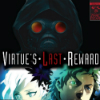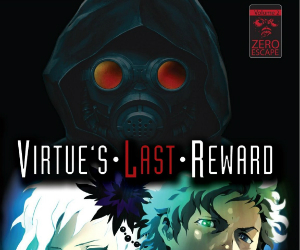 Game: Zero Escape: Virtue’s Last Reward
Game: Zero Escape: Virtue’s Last Reward
Developer: Chunsoft
Publisher: Rising Star Games (Europe & Australia), Aksys Games (North America)
Available on: PlayStation Vita, 3DS
Reviewed on: PlayStation Vita
When I was a kid I used to adore those Fighting Fantasy “Choose your own adventure” books. I would spend hours engrossed in Ian Livingstone classics like ‘The Warlock of Firetop Mountain’, ensconced in my bedroom with various dice, spinners, pencils and rubbers, negotiating the branching paths of those page-turning, cleverly assembled books, desperate to avoid making the wrong choice and thus ending my involvement until the next readthrough. I never really progressed on from this type of book as fashion dictates, harder drugs like Dungeons & Dragons and Shadowrun were never avenues I went down, but I do love the way that an essence of these books, with their multiple choices, branching endings and sense of mystery, has found its way into the video games that I still hold beloved as a man of some thirty odd years of age.
Games developers have been blurring the boundaries between a multi-layered novel and games for ages, creating some classic works in which depth and quality of story are just as important as action. Hideo Kojima is an example of someone who has always imbued his art with rich storytelling and ambiguous endings. Take a look at Snatcher, his Blade Runner-esque graphic adventure that is as much a noir cyberpunk novel than a guns blazing video game. Metal Gear aside, Kojima has explored this “visual novel” style further with his work on the Tokimeki Memorial series. Handhelds have, in recent times, been the perfect devices for games of this type. The Ace Attorney series, Hotel Dusk, Another Code, even Professor Layton, all offer story-driven gameplay, sometimes with a combination of action or puzzles, sometimes with no action at all.
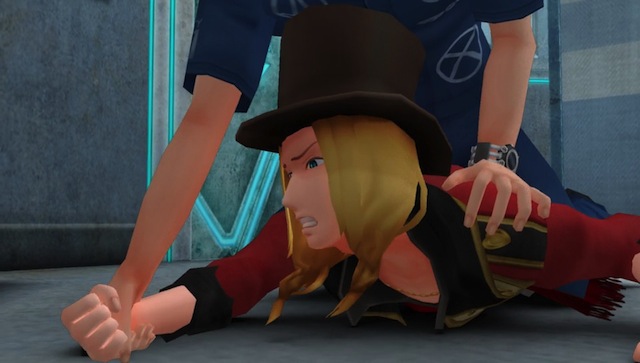
Back in 2009, Chunsoft scored something of a sleeper hit with their own take on the visual novel genre, the excellent 999: Nine Hours, Nine Persons, Nine Doors, which weaved a labyrinthine story involving imprisonment, betrayal, and a replica of the HMS Titanic around a neat set of puzzles. It did not actually reach Europe, but was localised for a US release a year later, meaning that text adventure fans in the Eurozone could easily import themselves a bit of region-free action. A sequel was announced in 2011, and this time around Chunsoft ensured that it reached all of the four major gaming territories. It may have taken us a few months longer than our Japanese buddies, but here were are, with an excellent PAL version of what has turned out to be a highly accomplished sequel, and one of the most intriguing, compulsive handheld games of the year.
You play the role of a young man by the name of Sigma, a mild mannered college student who one day finds himself kidnapped and locked inside an elevator with a mysterious young lady by the name of Phi, who claims that she knows him. As if this horrible claustrophobic situation couldn’t get any worse, the pair is then taunted by a computer generated rabbit on a monitor panel within their prison. The lupine menace explains that they have to escape the lift, and the first puzzle section of the game kicks off in earnest.
The touchscreen is used to look around, manipulate the scenery, open things, examine objects and suchlike. Sometimes it can be a bit awkward and cumbersome, and I would imagine that this aspect of the game would work better on the 3DS port. Having said that, the dual-layered puzzles, which reward you with extra unlockable files relating to the story if completed in their entirety, are challenging and genuinely mind-bending in nature. If you enjoy Professor Layton, can remember The Krypton Factor or were ever enthralled at the sight of Richard O’Brien bounding around on Channel 4, then you will love this side of the game. Although the first puzzle is relatively mundane, involving matching different shaped and coloured screws, things do pick up and there are later puzzles that incorporate more physical and mental effort – block pushing, code breaking, sudoko-style number crunching, etc – which will really get your grey matter working overtime.
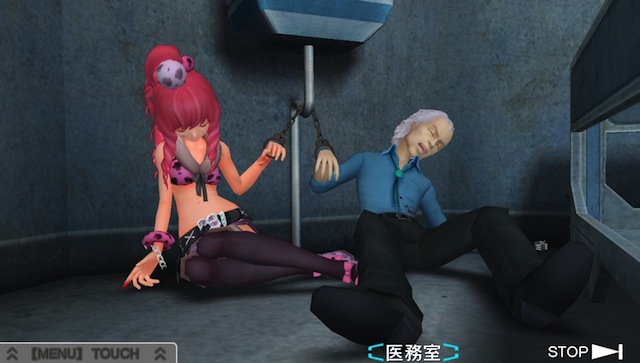
What really makes these puzzles count, however, is their context, and why you are solving them in the first place. Upon escaping the lift, Sigma finds himself trapped, along with eight others, in a stark warehouse, where the psychopath rabbit advises them all that they are now playing the deadly Nonary Game, a cruel affair in which the individuals, all of whom are equipped with a bracelet that they are unable to remove, compete to earn enough “Bracelet Points” in order to open a door that will lead to their freedom. The door will only open once. The twist is that every so often, the characters must vote whether to stick by or betray one of their cellmates, which can lead to losing or gaining BP depending on the situation. If you ally with one someone, you both gain BP. Betray someone, however, and you will gain a point whilst your “enemy” loses one of theirs. This is more than a mere Big Brother-style game though, once people start dying, which occurs when their BP reaches zero, the game takes on a sense of overwhelming, gathering dread, and each decision you make becomes a moral dilemma.
The importance of the decisions you make is undoubtedly a direct result of the mostly excellent script and characterisation in the game. Some are calling this the best story driven game of the year – and it is certainly up there – however there are simply too many flaws to elevate it to classic status. There are nine very diverse individuals to interact with, all excellently designed in the visual stakes, the folks now rendered as 3D models as opposed to the 2D-ers from 999. Sure, they are often lacking in frames of animation, repeating the same gestures regardless of the situation (such as smiling angelically whilst describing a horrific death). I will let that slide however, this is a visual novel, after all, I am not expecting the Unreal Engine. Every character has their own backstory, their own nuances and foibles, and you will genuinely want to explore each and every one of them to find out all of what the game has to offer. The problem comes from the fact that the script can quite often be a little lost in translation. There is also a lot of crude, unnecessary bad language and innuendo on display. I love a good swear as much as the next man, but sometimes the f-bombs drop literally out of nowhere. Dio is the main repeat offender in this regard. It is clear from the outset that he is supposed to be mean and uncaring, but the harsh language is still quite shocking. While the game has a stirring, tense soundtrack courtesy of Ridge Racer composer Shinji Hosoe, the voice acting in the European version is entirely in Japanese. This will not be to everyone’s tastes.
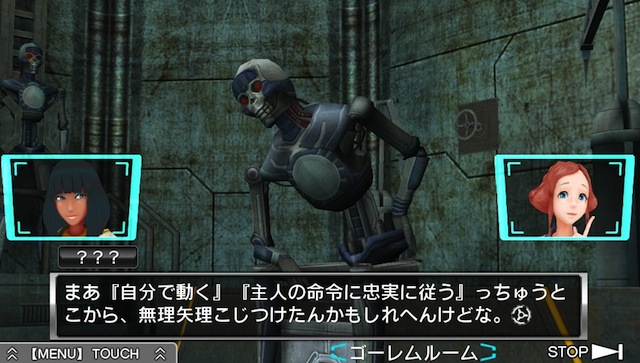
There are a seemingly endless array of endings possible as a result of the lengthy branching plot, and you can keep track of which plotlines you have already visited thanks to a brilliantly implemented in-game flowchart which breaks the narrative down into a touch-operated branching timeline which tells you which puzzles you have solved, and logs every decision that you make. There is also a notepad that you can use to jot down notes.
VERDICT: There are a few niggles that could have been ironed out within the sometimes clunky script and often-suspect touchscreen controls during the tension-heavy puzzle sections, but that doesn’t make this a bad game and on the whole this is an excellent localisation job and a completely unique handheld experience, quite unlike anything else I have played this year. The idea of trawling through reams of text may sound off putting, but once you start reaching the points where tricky moral decisions need to be made, you will find beads of sweat forming on your forehead as you curse that bloody rabbit for making you play his horrific Saw style game of betrayal and death. Fans of the genre will be delighted with Rising Star Games for doing the business and getting this game put out over here, although there is a certain amount of crossover potential here too. Try getting a crime drama-loving relative on this one after a few Christmas tipples, and you will see what I mean. Betraying your mates has never been so attractive.



